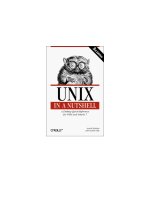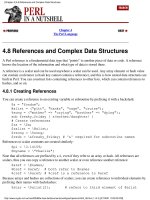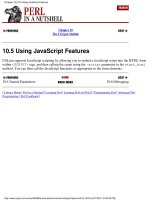Java Enterprise in a Nutshell, 3rd Edition potx
Bạn đang xem bản rút gọn của tài liệu. Xem và tải ngay bản đầy đủ của tài liệu tại đây (10.47 MB, 4,064 trang )
Java Enterprise in a Nutshell,
3rd Edition
Table of Contents
Copyright
Preface
What's New in This Edition
Contents of This Book
Java Programming Resources
Examples Online
Conventions Used in This Book
Using Code Examples
Safari® Enabled
Comments and Questions
Acknowledgments
Part I: The Java Enterprise
APIs
Chapter 1. Introduction
Section 1.1. Enterprise
Computing Defined
Section 1.2. Enterprise
Computing Demystified
Section 1.3. Standard Java
Enterprise APIs
Section 1.4. De Facto Standard
Enterprise Development Tools
Section 1.5. An Enterprise
Computing Scenario
Section 1.6. Other Enterprise
APIs
Chapter 2. Application
Assembly and Deployment
Section 2.1. J2EE Application
Assembly Model
Section 2.2. Component
Modules
Section 2.3. Application
Assemblies
Section 2.4. Deploying J2EE
Applications
Chapter 3. Java Servlets
Section 3.1. Getting a Servlet
Environment
Section 3.2. Servlet Basics
Section 3.3. Web Applications
Section 3.4. Servlet Requests
Section 3.5. Servlet Responses
Section 3.6. Custom Servlet
Initialization
Section 3.7. Security
Section 3.8. Servlet Filters
Section 3.9. Thread Safety
Section 3.10. Cookies
Section 3.11. Session Tracking
Section 3.12. Databases and
Non-HTML Content
Chapter 4. JavaServer Pages
Section 4.1. JSP Basics
Section 4.2. JSP Actions
Section 4.3. The JSP
Expression Language
Section 4.4. JSP Standard Tag
Library
Section 4.5. Custom Tags
Section 4.6. Wrapping Up
Chapter 5. JavaServer Faces
Section 5.1. The Sample
Application
Section 5.2. Structure of a JSF
Application
Section 5.3. Managed Beans
Section 5.4. The JSF
Expression Language
Section 5.5. JSF Actions and
Views
Section 5.6. Building Tables
Section 5.7. Validation
Section 5.8. Moving on with
JSF
Chapter 6. Enterprise
JavaBeans
Section 6.1. What Version Is
Covered Here?
Section 6.2. EJB Component
Model Overview
Section 6.3. EJB Tutorial
Section 6.4. Deploying EJBs
Section 6.5. Using Enterprise
JavaBeans
Section 6.6. Session Bean
Specifics
Section 6.7. Entity Beans
Section 6.8. Message-Driven
Beans
Section 6.9. Transaction
Management
Section 6.10. EJB 3.0
Chapter 7. Java and XML
Section 7.1. Using XML
Documents
Section 7.2. Java API for XML
Processing
Section 7.3. SAX
Section 7.4. DOM
Section 7.5. XSLT
Chapter 8. JDBC
Section 8.1. JDBC
Architecture
Section 8.2. Connecting to the
Database
Section 8.3. Statements
Section 8.4. Results
Section 8.5. Handling Errors
Section 8.6. Prepared
Statements
Section 8.7. BLOBs and
CLOBs
Section 8.8. Metadata
Section 8.9. Transactions
Section 8.10. Stored
Procedures
Section 8.11. Escape
Sequences
Section 8.12. RowSets
Chapter 9. JNDI
Section 9.1. JNDI Architecture
Section 9.2. A Simple Example
Section 9.3. Introducing the
Context
Section 9.4. Looking Up
Objects in a Context
Section 9.5. The NamingShell
Application
Section 9.6. Listing the
Children of a Context
Section 9.7. Creating and
Destroying Contexts
Section 9.8. Binding Objects
Section 9.9. Accessing
Directory Services
Section 9.10. Modifying
Directory Entries
Section 9.11. Creating
Directory Entries
Section 9.12. Searching a
Directory
Section 9.13. Event
Notification
Chapter 10. J2EE Security
Section 10.1. Basic Security
Concepts
Section 10.2. A Look at Java
and J2EE Security Standards
Section 10.3. Declarative
Security Versus Programmatic
Security
Section 10.4. Web Component
Security
Section 10.5. EJB Component
Security
Section 10.6. Other J2EE
Security Topics
Section 10.7. Limitations of
J2EE Security
Chapter 11. Java Message
Service
Section 11.1. JMS in the J2EE
Environment
Section 11.2. Elements of
Messaging with JMS
Section 11.3. The Anatomy of
Messages
Section 11.4. Point-to-Point
Messaging
Section 11.5. Publish-
Subscribe Messaging
Section 11.6. Unified
Messaging
Section 11.7. Transactional
Messaging
Chapter 12. Web Services with
JAX-RPC and SAAJ
Section 12.1. What's Covered
Here?
Section 12.2. Brief
Introduction to Web Services
Section 12.3. Java Web
Services
Section 12.4. Writing Web
Service Clients
Section 12.5. Writing Web
Services
Section 12.6. Deploying Web
Services
Chapter 13. Remote Method
Invocation
Section 13.1. What's Covered
Here?
Section 13.2. Introduction to
RMI
Section 13.3. Defining Remote
Objects
Section 13.4. Creating the
Stubs and Skeletons
Section 13.5. Accessing
Remote Objects as a Client
Section 13.6. Dynamic
Classloading
Section 13.7. Remote Object
Activation
Section 13.8. RMI and Native
Method Calls
Section 13.9. RMI Over IIOP
Chapter 14. Java IDL
(CORBA)
Section 14.1. A Note on
Evolving Standards
Section 14.2. The CORBA
Architecture
Section 14.3. Creating CORBA
Objects
Section 14.4. Putting It in the
Public Eye
Section 14.5. Finding and
Using Remote Objects
Section 14.6. What If I Don't
Have the Interface?
Chapter 15. JavaMail
Section 15.1. Email and
JavaMail
Section 15.2. Creating and
Sending Messages
Section 15.3. Retrieving
Messages
Section 15.4. Multipart
Messages
Chapter 16. Transactions
Section 16.1. Transaction
Overview
Section 16.2. Programmatic
Transactions Versus
Declarative Transactions
Section 16.3. Optimistic
Concurrency
Section 16.4. EJB Transaction
Management
Section 16.5. Some Common
Programming Scenarios
Section 16.6. Transaction Best
Practices
Part II: Open Source
Enterprise Tools
Chapter 17. Ant
Section 17.1. What Version Is
Covered Here?
Section 17.2. Ant Overview
Section 17.3. Ant
Fundamentals
Section 17.4. Core Tasks
Section 17.5. Enterprise Tasks
Section 17.6. Creating Portable
Build Processes
Chapter 18. JUnit and Cactus
Section 18.1. What's Covered
Here?
Section 18.2. Unit Testing
Concepts
Section 18.3. JUnit Overview
Section 18.4. Using JUnit with
Ant
Section 18.5. Testing
Enterprise Components with
Cactus
Chapter 19. Struts
Section 19.1. The Scope of
Struts
Section 19.2. The Sample
Application
Section 19.3. The
Development Process with
Struts
Section 19.4. The Struts
Controller
Section 19.5. The Action Class
Section 19.6. Views in Struts
Section 19.7. Struts Tags
Section 19.8. Struts Plug-ins
Section 19.9.
DynaActionForms and the
Struts Validator
Chapter 20. Hibernate
Section 20.1. The Sample
Application
Section 20.2. Principles of
Hibernate
Section 20.3. Configuration
and Mapping
Section 20.4. The Hibernate
API
Section 20.5. HQL (Hibernate
Query Language)
Section 20.6. Hibernate
Services
Section 20.7. Conclusion
Chapter 21. Annotations with
XDoclet and J2SE Metadata
Section 21.1. What's Covered
Here?
Section 21.2. What Are Code
Annotations?
Section 21.3. Annotation Tools
Section 21.4. XDoclet Tutorial
Section 21.5. J2SE Annotations
Tutorial
Part III: Appendixes
Appendix A. J2EE
Deployment Descriptor
Reference
Section A.1. Web Components
(web.xml)
Section A.2. Enterprise
JavaBeans (ejb-jar.xml)
Section A.3. Application
Archives (application .xml)
Section A.4. Web Services
(webservices.xml)
Section A.5. Web Service
Java/WSDL Mappings
Appendix B. JavaServer Faces
Tag Libraries
Section B.1. JSF Core Tags
Section B.2. JSF HTML Tags
Appendix C. Enterprise
JavaBeans Query Language
Syntax
Section C.1. Basic Structure of









